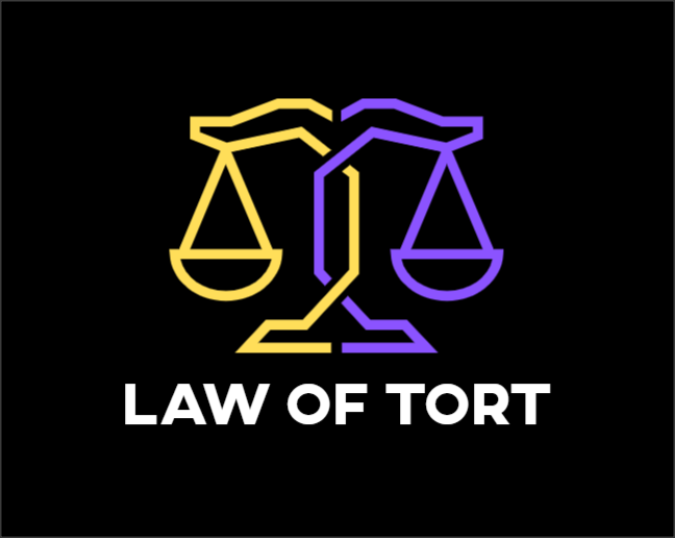This article is written by Gaurav Purohit from Amity University Rajasthan Currently Pursuing BBA LLB.
Definition of Tort
The word Tor has been derived from the Latin word “tortum” which means curved or crooked. Definition as given by the jurist Salmond, Tort is a civil wrong for which the remedy is the action for unliquidated damages (damages which are not fixed) in common law, and it is not considered exclusively as a breach of contract or breach of trust or and other equitable remedies.
It is unique in relation to breach of agreement or contract and trust. A tort is when the act of one party causes harm to another party which is due to negligence or carelessness on part of another party. The person who files the suit is known as the Plaintiff and the person against whom the suit has been filed is known as the defendant.
The individual who causes such damage will be made subject to pay compensation to the injured party (offended party), this compensation can include cash. This money which has been received as compensation is called Damages. So as to claim damages, there must be some breach of obligation towards the plaintiff which resulted in injury. Regardless of whether the damage which is caused was not intentional but rather because of carelessness or negligence, then the other party can be sued. Tort permits individuals to consider the other individual responsible for the wounds which are suffered by them.
According to P.H. Winfield– Tortious Liability arises from the Breach of Duty which is primarily fixed by Law. The duty is towards persons generally and the breach of duty is repressible by an Action for Unliquidated damages ( The damages which are not fixed )
The Limitation Act 1963 defines Tort as a Civil Wrong which is different from the Breach of Contract or Breach of Trust
Essential Elements of Law of Tort
- Act or Omission: To establish a tort there must be an act, which can either be negative or positive. There must be some breach of the obligation to comprise such a wrongful act or omission. It implies there was an obligation to do or not to do a specific activity, or to carry on in a specific way in which a sensible man is relied upon to act under certain conditions.
For example, if someone fails to help a starving man then he should not be held liable because he was not having any legal obligation to help that starving man and it was just a moral wrong.
- Legal Damage: In order to establish tort, breach of lawful obligation must be present. The lawful right vested with the party who files the suit should have been breached i.e certain act or omission brought about the breach of legal obligation. The action can be established if there is a breach of a legal right. The injury sustained by the plaintiff then the damages could be claimed by the plaintiff.
Injuria Sine Damnum
Injuria sine damnum: Injuria means the violation of the legal right of an individual and Damnum means loss or damage suffered by the plaintiff as in terms of cash, health. When there is an infringement of a legal right with no damage caused to the plaintiff then its actionable in the Court of Law and plaintiff can approach the court.
In Ashby v. White[1], the injured party was confined by the respondent, a returning officer. The injured party was a qualified voter according to the law at the parliamentary election yet because of confinement, his democratic right to vote was violated. The injured party sued the defendant for infringement of his legal right. Where there is a right there is a remedy available for it.
In Bhim Singh v. State of J&K[2], the injured party was an MLA of J&K who was wrongfully detained by the police officers while he planned to go to the Assembly meeting. The Fundamental Right of individual liberty was disregarded and additionally, he was not produced before the magistrate inside the requisite period of time. Here the malicious and wrongful act of the respondent was actionable in the court of law and the court awarded exemplary damages of Rs 50000 to the Plaintiff Bhim Singh.
Damnum Sine Injuria
Damnum sine injuria: According to this maxim there should be some injury caused to the injured party without any unauthorized interference with the legal right of Plaintiff. An individual can’t claim damages even if the injury was caused due to the intentional act of the defendant until such a party exercises his legal right. For example, the defendant set up a school precisely in front of the school of the plaintiff. The plaintiff suffered loss because of this act committed by the Defendant as he himself has to lower down the fees due to this competition between him and the defendant school. It was held that that was no remedy available to the plaintiff for the loss incurred by him as the defendant was just exercising his legal right.
In the Gloucester Grammar School Case[3], the defendant was a teacher in the plaintiff’s school., the respondent left the plaintiffs school and discovered an opponent school next thereto of the plaintiff. Since the respondent was well known among students for his skills of teaching, many students left the plaintiffs school and joined the school of the defendant. The party sued the respondent for the financial loss caused to him by the defendant school
It was held that no suit could lie against the respondent as the respondent was not liable. Compensation isn’t any ground of activity but the money-related loss is caused however in the event that no right was violated. The respondent had legitimately established his school and didn’t violate any rights of the plaintiff in doing as such the students prior who were studying in the appealing party’s school loved the skills of the teaching of the defendant, subsequently, it had been their choice to choose the institution to review in. The appealing party couldn’t stop the defendant to maintain the business as a Competition at his school.
Development of Law of Torts in India
To deal with the malicious conduct of the individual’s tort existed in Hindu and Muslim law yet it tends to be said that tort was officially presented by the Crown in India. It is completely based on equity justice and good conscience. The law of Torts is also based on the principles of Common Law which is mainly the English law of Tort. The utilization of the law of tort is applied specifically in Indian courts while keeping in mind whether it suits the conditions of Indian culture and society
Justice Bhagwati in M.C Mehta v. Union of India that:
We need to advance new standards and set down new norms that will sufficiently manage new issues that emerge in a highly industrialized economy. We can’t permit our judicial thinking to be built by reference to the law as it prevails in England or for the matter of that in any foreign nation. We are absolutely set up to get light from whatever source it comes yet we need to construct our own Jurisprudence.
Difference between Tort and Crime
| TORT | CRIME |
| Proceedings take place in Civil Court. | Proceedings take place in Criminal Court |
| Violation of Private Rights | Violation of Public Rights and duties can affect the whole community. |
| Not Codified and Judge Made Laws | Codified and all punishments are defined |
| The remedy is Unliquidated Damages | The remedy is Punishment to the Offender |
Difference Between Tort and Breach of Contract
| TORT | BREACH OF CONTRACT |
| Uncodified Law | Codified Law |
| Duty is Fixed by Law | Duty is Fixed by Parties |
| Right in Rem | Right in Personam |
| Duty towards Persons Generally | Duty Towards Specific Person |
CONCLUSION
The tort is a Civil Wrong but every Civil Wrong should not be Considered as a Tort and it is redressable by an action for unliquidated damages and which is different from breach of contract or breach of trust. In a suit for damages in tort, the court generally awards pecuniary compensation to the plaintiff for the damage or injury caused to the party against whom tort is committed by the Wrongful Act of Defendant.
[1] Ashby v. White 1703) 92 ER 126.
[2] Bhim Singh v. State of J&K AIR 1986 SC 494.
[3] Gloucester Grammar School Case ((1411), Y. B. 11 Hen. 4, f. 47, pi. 19)
Latest Posts
- Job opportunity at EXO Edge, Sahibzada Ajit Singh Nagar, Punjab, India: Apply Now!!

- Internship opportunity at Vishwas Advisors, Kalyan, Maharashtra, India: Apply Now!!

- Internship opportunity at Kulfi Collective, Mumbai, Maharashtra, India: Apply Now!

- Job opportunity at The Neotia University, Diamond Harbour, West Bengal, India: Apply Now !!

- Job opportunity at Morgan Stanley, Mumbai, Maharashtra, India: Apply Now!!

- Job opportunity at VISA INTELLIGENCE CONSULTANCY LLP, New Delhi, Delhi, India: Apply Now!!

- Job opportunity at Amazon Web Services (AWS), Gurugram, Haryana, India: Apply Now!!

- Job opportunity at Stelcore Management Services Private Limited, Mumbai, Maharashtra, India: Apply Now!!

- Job opportunity at Zscaler, Sahibzada Ajit Singh Nagar, Punjab, India: Apply Now!!

- Job opportunity at Irish Expert, Delhi, India: Apply Now!!

- Job opportunity at UnitedLex · Gurgaon, Haryana, India: Apply Now!

- Internship opportunity at Vineforce · Nabha, Punjab, India: Apply Now!!

- CLAT-Peeps! (10)
- Current Affairs (2)
- competitions (132)
- Conferences and Seminars (201)
- Webinar (1)
- Course and Workshops (107)
- Debates (46)
- Eassy Competitions (69)
- Fellowships & Scholarships (56)
- Guest Blogs (6)
- important (29)
- Internships and Jobs (2,317)
- interviews (8)
- moot court (180)
- Opportuintes (2,731)
- Job Opportunity (1,191)
- opportunity (2,559)
- Call for papers (475)
- Quizes,fests and others (298)
- Work Opportunity (836)
- Our Blog (1,049)
- Administrative Law (17)
- ADR (13)
- Arms Act (2)
- Case Analysis (205)
- Company law (36)
- Constitutional Law (143)
- Consumer Protection Act (17)
- Contract Law (62)
- CPC (10)
- Criminal Law (140)
- Cyber Law (13)
- Environmental Laws (30)
- Evidence Act (20)
- Family Law (12)
- General (205)
- International Humanitarian Law (8)
- International law (23)
- IPR (10)
- Jurisprudence (13)
- labor laws (7)
- Maritime Laws (1)
- Partnership Act (2)
- personal law (33)
- Taxation (10)
- Tort (64)
- Transfer of Property (2)
- Our Services (11)
- career advice (2)
- others (6)
- Top Stories (524)
- Uncategorized (720)
Archives
- November 2023
- October 2023
- September 2023
- August 2023
- July 2023
- June 2023
- May 2023
- April 2023
- March 2023
- February 2023
- January 2023
- December 2022
- November 2022
- October 2022
- September 2022
- August 2022
- July 2022
- June 2022
- May 2022
- April 2022
- March 2022
- February 2022
- January 2022
- December 2021
- November 2021
- October 2021
- September 2021
- August 2021
- July 2021
- June 2021
- May 2021
- April 2021
- March 2021
- February 2021
- January 2021
- December 2020
- November 2020
- October 2020
- September 2020
- August 2020
- July 2020
- June 2020
- May 2020
- April 2020
- February 2020
- January 2020
- November 2019

